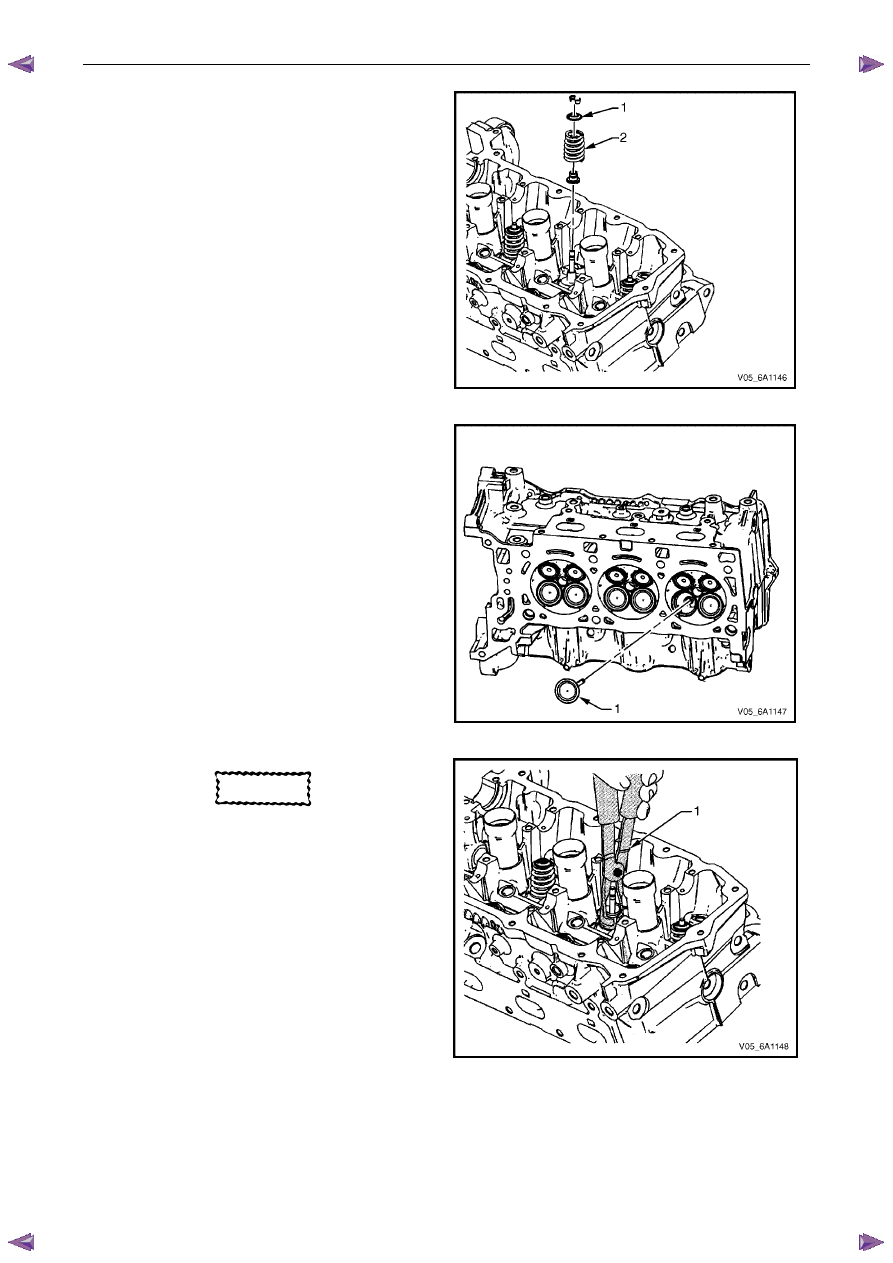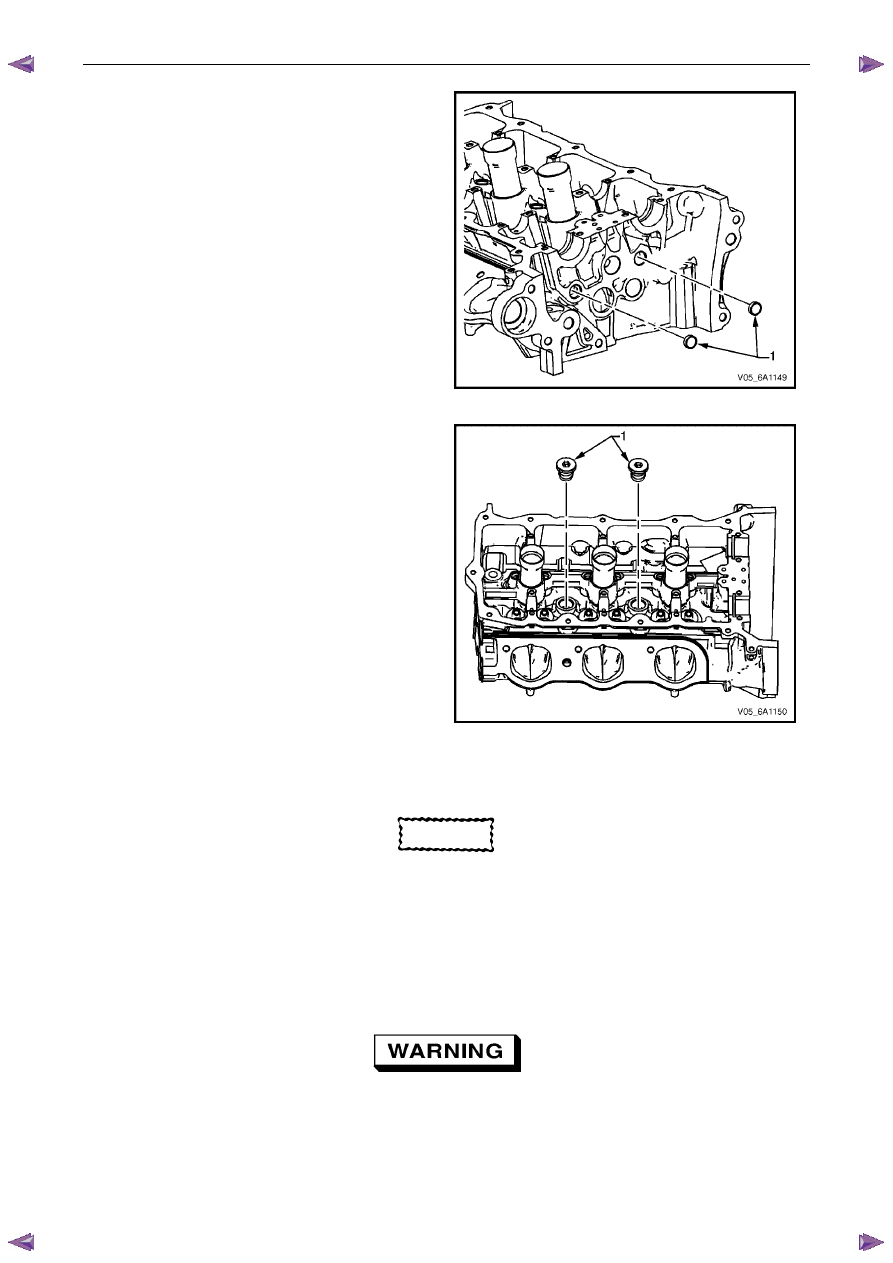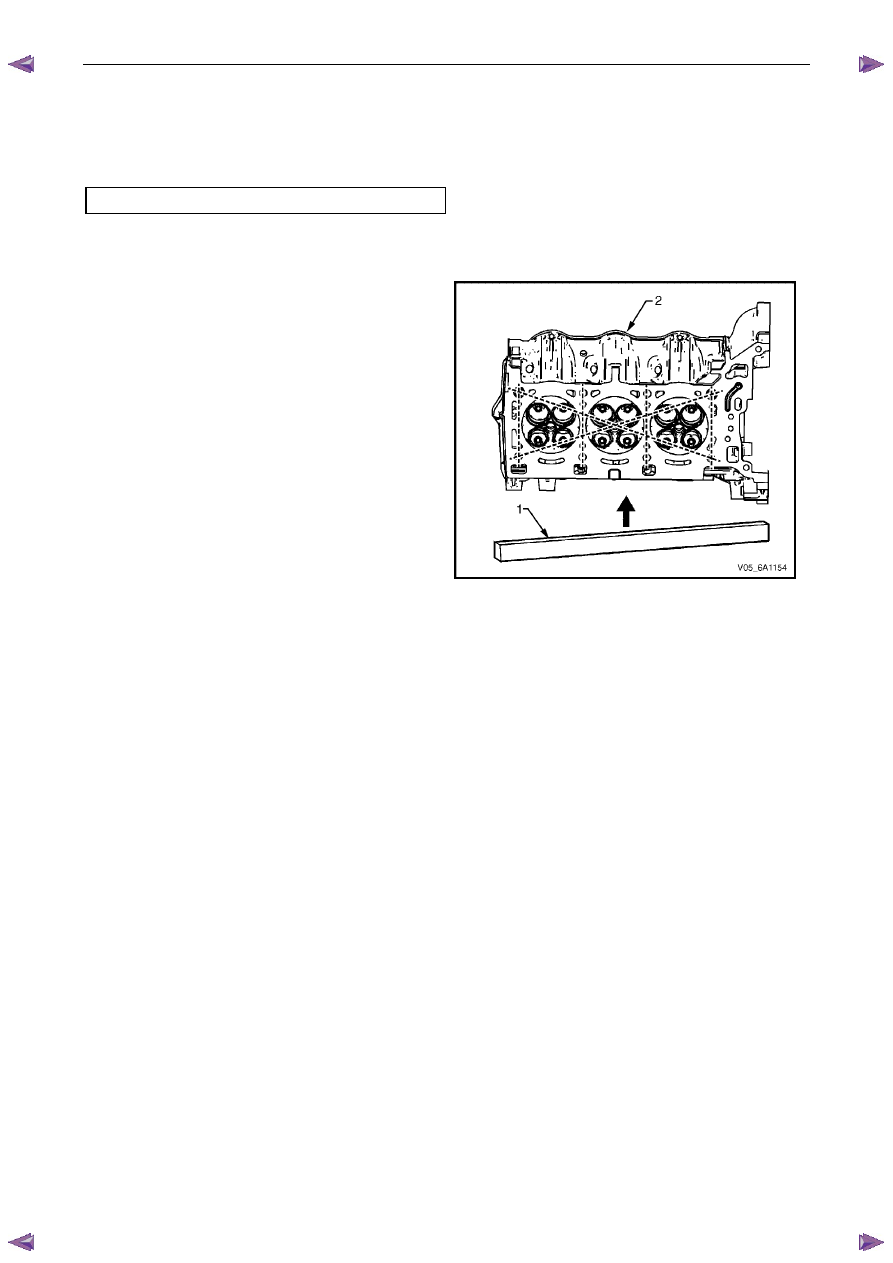Isuzu KB P190. Manual — part 661

Engine Mechanical – V6
Page 6A1–165
5
Remove the valve spring retainer (1).
6
Remove the valve spring (2).
Figure 6A1 – 282
7
Remove the valves (1).
Figure 6A1 – 283
CAUTION
Never reuse a valve stem oil seal.
8
Remove the valve stem oil seal using Tool No.
EN-46116 and discard.
9
Repeat these procedures for the remaining valves.
Figure 6A1 – 284

Engine Mechanical – V6
Page 6A1–166
10
Remove the cylinder head oil gallery expansion
plugs (1).
Figure 6A1 – 285
11
Remove the cylinder head coolant threaded plugs (1).
Figure 6A1 – 286
Clean
CAUTION
Due to the aluminium alloy construction of
the cylinder head, wire brushes and steel
scrapers must not be used during the
cleaning process, as damage to sealing
surfaces may occur. Use a wood or plastic
scraper as an alternative.
1
Remove any old thread sealant, gasket material or sealant using commercially available plastic or wooden scraper.
2
Clean all cylinder head surfaces with non-corrosive solvent.
Safety glasses must be worn when using
compressed air.
3
Blow out all the oil galleries using compressed air.
4
Remove any carbon deposits from the combustion chambers.
5
Clean any debris or build-up from the lifter pockets.

Engine Mechanical – V6
Page 6A1–167
Inspect
Visual Inspection
1
Inspect the cylinder head (1) camshaft bearing
surfaces for the following conditions:
•
excessive scoring or pitting,
•
discoloration from overheating, and
•
deformation from excessive wear.
2
If any of the above conditions exist on the camshaft
bearing surfaces, replace the cylinder head. Do not
machine the camshaft bearing journals.
Figure 6A1 – 287
3
Inspect the cylinder head for the following:
•
Cracks, damage or pitting in the combustion chambers.
•
Debris in the oil galleries. continue to clean the galleries until all debris is removed.
•
Coolant leaks or damage to the deck face sealing surface. if coolant leaks are present, measure the surface
warpage as described under Cylinder Head Measurement within this Section.
•
Burrs or any defects that would degrade the sealing of a new secondary camshaft chain tensioner gasket.
•
Damage to any gasket surfaces.
•
Damage to any threaded bolt holes.
•
Burnt or eroded areas in the combustion chamber.
•
Cracks in the exhaust ports and combustion chambers.
•
External cracks in the water passages.
•
Restrictions in the intake or exhaust passages.
•
Restrictions in the cooling system passages.
•
Rusted, damaged or leaking core plugs.
4
If the cylinder head is cracked or damaged, it must be replaced. No welding or patching of the cylinder head is
recommended.
Cylinder Head Measurement
N O T E
For all cylinder head and associated component
specifications, refer to 5
Specifications.
Camshaft Journal Clearance
1
Install the camshaft bearing cap in the cylinder head without the camshaft.
2
Install the camshaft cap bolts and tighten to the correct torque specification
Camshaft bearing cap attaching bolt. . 8.0 – 12.0 Nm.
3
Measure the camshaft bearings using an inside micrometer.
4
Subtract the camshaft journal diameter from the camshaft bearing diameter. This will provide the running clearance.
If the running clearance exceeds specifications and the camshaft journals are within specification, replace the
cylinder head.
Camshaft Journal Alignment
1
Ensure the camshafts are serviceable, refer to 3.19
Camshaft for measuring procedures.

Engine Mechanical – V6
Page 6A1–168
2
Inspect the cylinder head camshaft bearing surfaces for any imperfections or scratches that could inhibit correct
camshaft clearances. Repair minor imperfections or scratches.
3
Install the camshafts in the cylinder head.
4
Install the camshaft bearing caps.
5
Install the camshaft cap bolts and tighten to the correct torque specification.
Camshaft bearing cap attaching bolt. . 8.0 – 12.0 Nm.
6
Ensure the camshafts spin freely in the cylinder head. If the camshaft does not run freely, replace the cylinder head.
Deck Flatness Inspection
1
Ensure the cylinder head decks are clean and free of
gasket material.
2
Inspect the surface for any imperfections or scratches
that could inhibit correct cylinder head gasket sealing.
3
Place a straight-edge (1) diagonally across the
cylinder head (2) deck face surface.
4
Measure the clearance between the straight-edge
and the cylinder head deck face using a feeler gauge
at four points along the straight-edge.
5
If the warpage is less than 0.05 mm, the cylinder
head deck surface does not require resurfacing.
6
If the warpage is between 0.05±0.20 mm or any
imperfections or scratches that could inhibit correct
cylinder head gasket sealing are present, the cylinder
head deck surface requires resurfacing.
7
If resurfacing is required the maximum amount that
can be removed is 0.25 mm.
8
If the cylinder head deck surface requires more than
0.25 mm material removal the head must be
replaced.
Figure 6A1 – 288

Нет комментариевНе стесняйтесь поделиться с нами вашим ценным мнением.
Текст